View in other NatureServe Network Field Guides
NatureServe
Montana
Utah
Wyoming
Idaho
Wisconsin
British Columbia
South Carolina
Yukon
California
New York
Golden-mantled Ground Squirrel - Callospermophilus lateralis
Native Species
Global Rank:
G5
State Rank:
S5
(see State Rank Reason below)
Agency Status
USFWS:
USFS:
BLM:
External Links
State Rank Reason (see State Rank above)
Species is common within suitable habitat across western and southcentral Montana. No threats are identified.
General Description
We do not yet have descriptive information on this species. Please try the buttons above to search for information from other sources.
Species Range
Montana Range
Range Descriptions
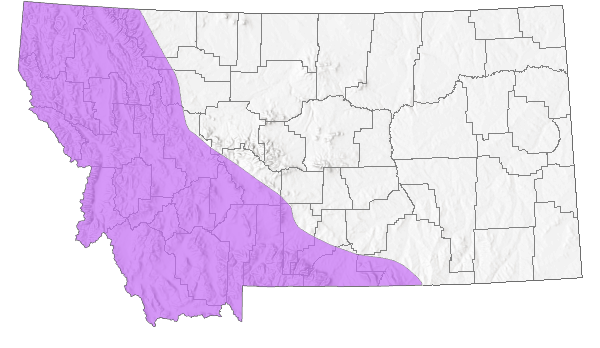
 Native
Native
Western Hemisphere Range
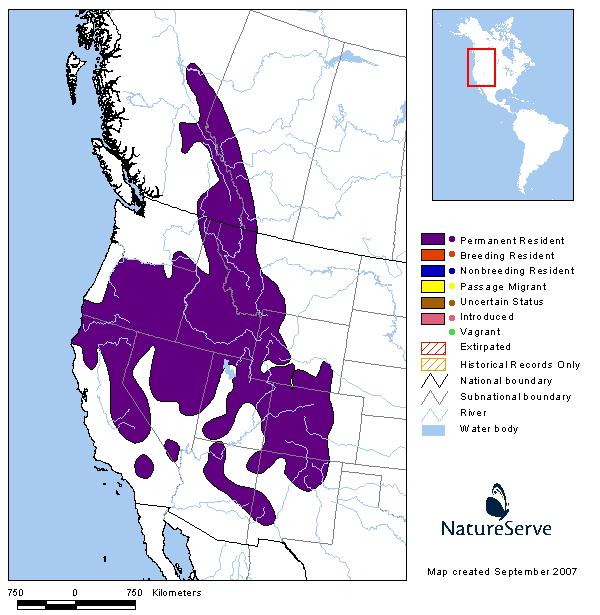
Observations in Montana Natural Heritage Program Database
Number of Observations: 865
(Click on the following maps and charts to see full sized version)
Map Help and Descriptions
Relative Density
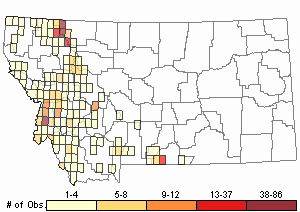
Recency
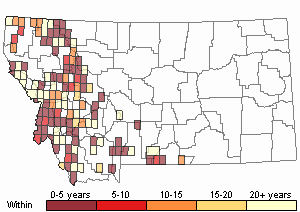
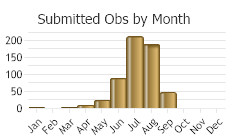
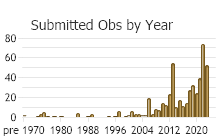
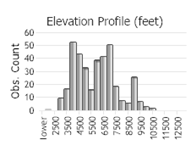 (Observations spanning multiple months or years are excluded from time charts)
(Observations spanning multiple months or years are excluded from time charts)
Migration
Non-migratory.
Habitat
Occurs throughout the montane and subalpine forests, wherever rocky habitat (outcrops and talus slopes) is present. It will range above timberline and even (in summer, at least) into alpine tundra (Hoffmann and Pattie 1968).
Ecological Systems Associated with this Species
- Details on Creation and Suggested Uses and Limitations
How Associations Were Made
We associated the use and habitat quality (common or occasional) of each of the 82 ecological systems mapped in Montana for
vertebrate animal species that regularly breed, overwinter, or migrate through the state by:
- Using personal observations and reviewing literature that summarize the breeding, overwintering, or migratory habitat requirements of each species (Dobkin 1992, Hart et al. 1998, Hutto and Young 1999, Maxell 2000, Foresman 2012, Adams 2003, and Werner et al. 2004);
- Evaluating structural characteristics and distribution of each ecological system relative to the species' range and habitat requirements;
- Examining the observation records for each species in the state-wide point observation database associated with each ecological system;
- Calculating the percentage of observations associated with each ecological system relative to the percent of Montana covered by each ecological system to get a measure of "observations versus availability of habitat".
Species that breed in Montana were only evaluated for breeding habitat use, species that only overwinter in Montana were only evaluated for overwintering habitat use, and species that only migrate through Montana were only evaluated for migratory habitat use.
In general, species were listed as associated with an ecological system if structural characteristics of used habitat documented in the literature were present in the ecological system or large numbers of point observations were associated with the ecological system.
However, species were not listed as associated with an ecological system if there was no support in the literature for use of structural characteristics in an ecological system,
even if point observations were associated with that system.
Common versus occasional association with an ecological system was assigned based on the degree to which the structural characteristics of an ecological system matched the preferred structural habitat characteristics for each species as represented in scientific literature.
The percentage of observations associated with each ecological system relative to the percent of Montana covered by each ecological system was also used to guide assignment of common versus occasional association.
If you have any questions or comments on species associations with ecological systems, please contact the Montana Natural Heritage Program's Senior Zoologist.
Suggested Uses and Limitations
Species associations with ecological systems should be used to generate potential lists of species that may occupy broader landscapes for the purposes of landscape-level planning.
These potential lists of species should not be used in place of documented occurrences of species (this information can be requested at:
mtnhp.mt.gov/requests) or systematic surveys for species and evaluations of habitat at a local site level by trained biologists.
Users of this information should be aware that the land cover data used to generate species associations is based on imagery from the late 1990s and early 2000s and was only intended to be used at broader landscape scales.
Land cover mapping accuracy is particularly problematic when the systems occur as small patches or where the land cover types have been altered over the past decade.
Thus, particular caution should be used when using the associations in assessments of smaller areas (e.g., evaluations of public land survey sections).
Finally, although a species may be associated with a particular ecological system within its known geographic range, portions of that ecological system may occur outside of the species' known geographic range.
Literature Cited
- Adams, R.A. 2003. Bats of the Rocky Mountain West; natural history, ecology, and conservation. Boulder, CO: University Press of Colorado. 289 p.
- Dobkin, D. S. 1992. Neotropical migrant land birds in the Northern Rockies and Great Plains. USDA Forest Service, Northern Region. Publication No. R1-93-34. Missoula, MT.
- Foresman, K.R. 2012. Mammals of Montana. Second edition. Mountain Press Publishing, Missoula, Montana. 429 pp.
- Hart, M.M., W.A. Williams, P.C. Thornton, K.P. McLaughlin, C.M. Tobalske, B.A. Maxell, D.P. Hendricks, C.R. Peterson, and R.L. Redmond. 1998. Montana atlas of terrestrial vertebrates. Montana Cooperative Wildlife Research Unit, University of Montana, Missoula, MT. 1302 p.
- Hutto, R.L. and J.S. Young. 1999. Habitat relationships of landbirds in the Northern Region, USDA Forest Service, Rocky Mountain Research Station RMRS-GTR-32. 72 p.
- Maxell, B.A. 2000. Management of Montana's amphibians: a review of factors that may present a risk to population viability and accounts on the identification, distribution, taxonomy, habitat use, natural history, and the status and conservation of individual species. Report to U.S. Forest Service Region 1. Missoula, MT: Wildlife Biology Program, University of Montana. 161 p.
- Werner, J.K., B.A. Maxell, P. Hendricks, and D. Flath. 2004. Amphibians and reptiles of Montana. Missoula, MT: Mountain Press Publishing Company. 262 p.
- Commonly Associated with these Ecological Systems
Alpine Systems
Forest and Woodland Systems
Grassland Systems
Human Land Use
Recently Disturbed or Modified
Shrubland, Steppe and Savanna Systems
Sparse and Barren Systems
Wetland and Riparian Systems
Food Habits
Apparently stores food in den.
Ecology
Short, simple, concealed burrows; entrance near rock, stump, log, or bush (Banfield 1974).
Reproductive Characteristics
Scant information available for Montana. Will breed as yearlings (Banfield 1974).
Stewardship Responsibility
References
- Literature Cited AboveLegend:
 View Online Publication
View Online Publication Banfield, A.W.F. 1974. The mammals of Canada. University of Toronto Press for National Museum of Natural Science and the National Museums of Canada, 438 pp.
Banfield, A.W.F. 1974. The mammals of Canada. University of Toronto Press for National Museum of Natural Science and the National Museums of Canada, 438 pp. Hoffmann, R.S. and D.L. Pattie. 1968. A guide to Montana mammals: identification, habitat, distribution, and abundance. Missoula, MT: University of Montana. 133 p.
Hoffmann, R.S. and D.L. Pattie. 1968. A guide to Montana mammals: identification, habitat, distribution, and abundance. Missoula, MT: University of Montana. 133 p.
- Additional ReferencesLegend:
 View Online Publication
View Online Publication
Do you know of a citation we're missing? Adelman, E.B. 1979. A survey of the nongame mammals in the Upper Rattlesnake Creek drainage of western Montana. M.S. thesis. University of Montana, Missoula. 129 pp.
Adelman, E.B. 1979. A survey of the nongame mammals in the Upper Rattlesnake Creek drainage of western Montana. M.S. thesis. University of Montana, Missoula. 129 pp. Anaconda Minerals Company, and Camp, Dresser & McKee. 1981. Anaconda Stillwater Project 6-month environmental baseline report. CDM Project No. 3139. Vol. I Appendix. Jan. 15, 1981.
Anaconda Minerals Company, and Camp, Dresser & McKee. 1981. Anaconda Stillwater Project 6-month environmental baseline report. CDM Project No. 3139. Vol. I Appendix. Jan. 15, 1981. Bartels, M.A., and D.P. Thompson. 1993. Spermophilus lateralis. Mammalian Species 440:1-8.
Bartels, M.A., and D.P. Thompson. 1993. Spermophilus lateralis. Mammalian Species 440:1-8. Butts, T.W., Western Technology and R.L. Eng. 1993. Continental Lime Indian Creek Mine, Townsend, MT. Life of Mine Wildlife Reconnaissance. In Life-of-Mine Amendment. Continental Lime, Inc., Indian Creek Mine & Plant. Vol. 2. October 13, 1992.
Butts, T.W., Western Technology and R.L. Eng. 1993. Continental Lime Indian Creek Mine, Townsend, MT. Life of Mine Wildlife Reconnaissance. In Life-of-Mine Amendment. Continental Lime, Inc., Indian Creek Mine & Plant. Vol. 2. October 13, 1992. Eng, R.L. 1976. Wildlife Baseline Study [for West Fork of the Stillwater and Picket Pin drainages]
Eng, R.L. 1976. Wildlife Baseline Study [for West Fork of the Stillwater and Picket Pin drainages] Farmer, Patrick J., and Thomas W. Butts, Western Technology & Eng., Inc., Helena, MT., 1994, McDonald Project Terrestrial Wildlife Study, November 1989 - November 1993. April 1994. In McDonald Gold Project: Wildlife & Fisheries. [#18]. Seven-up Pete Joint Venture, Lincoln, MT. Unpub. No date.
Farmer, Patrick J., and Thomas W. Butts, Western Technology & Eng., Inc., Helena, MT., 1994, McDonald Project Terrestrial Wildlife Study, November 1989 - November 1993. April 1994. In McDonald Gold Project: Wildlife & Fisheries. [#18]. Seven-up Pete Joint Venture, Lincoln, MT. Unpub. No date. Farmer, Patrick. J., et al., Western Technology and Eng., Inc., Helena, MT., 1984, Montana Tunnels Project Baseline Terrestrial Wildlife Study. December 14, 1984. In Application for a Hard Rock Operating Permit, Montana Tunnels Project, Jefferson County, Montana. Vol. 3. Environmental Baseline Reports. (Centennial Minerals, Inc., Hydrometrics, 1984?)
Farmer, Patrick. J., et al., Western Technology and Eng., Inc., Helena, MT., 1984, Montana Tunnels Project Baseline Terrestrial Wildlife Study. December 14, 1984. In Application for a Hard Rock Operating Permit, Montana Tunnels Project, Jefferson County, Montana. Vol. 3. Environmental Baseline Reports. (Centennial Minerals, Inc., Hydrometrics, 1984?) Foresman, K.R. 2001. The wild mammals of Montana. American Society of Mammalogists, Special Publication Number 12. Lawrence, KS. 278 pp.
Foresman, K.R. 2001. The wild mammals of Montana. American Society of Mammalogists, Special Publication Number 12. Lawrence, KS. 278 pp. Foresman, K.R. 2012. Mammals of Montana. Second edition. Mountain Press Publishing, Missoula, Montana. 429 pp.
Foresman, K.R. 2012. Mammals of Montana. Second edition. Mountain Press Publishing, Missoula, Montana. 429 pp. Hanauska-Brown, L., B.A. Maxell, A. Petersen, and S. Story. 2014. Diversity Monitoring in Montana 2008-2010 Final Report. Montana Fish, Wildlife & Parks. Helena, MT. 78 pp.
Hanauska-Brown, L., B.A. Maxell, A. Petersen, and S. Story. 2014. Diversity Monitoring in Montana 2008-2010 Final Report. Montana Fish, Wildlife & Parks. Helena, MT. 78 pp. Hoffmann, R.S., P.L. Wright, and F.E. Newby. 1969. The distribution of some mammals in Montana. I. Mammals other than bats. Journal of Mammalogy 50(3): 579-604.
Hoffmann, R.S., P.L. Wright, and F.E. Newby. 1969. The distribution of some mammals in Montana. I. Mammals other than bats. Journal of Mammalogy 50(3): 579-604. Johnson, L.J. 1960. Mammal studies on the Lubrecht Forest, Montana: a preliminary report. Proc. Mont. Acad. Sci. 20: 40-47.
Johnson, L.J. 1960. Mammal studies on the Lubrecht Forest, Montana: a preliminary report. Proc. Mont. Acad. Sci. 20: 40-47. Joslin, Gayle, and Heidi B. Youmans. 1999. Effects of recreation on Rocky Mountain wildlife: a review for Montana. [Montana]: Montana Chapter of the Wildlife Society.
Joslin, Gayle, and Heidi B. Youmans. 1999. Effects of recreation on Rocky Mountain wildlife: a review for Montana. [Montana]: Montana Chapter of the Wildlife Society. Kujala, Quentin J., 1993, Winter habitat selection and population status of pine marten in southwest Montana. W-100-R-4-6, V, FB-1, Sub-project no. 1, 2, Job no. 3. Statewide Wildlife Program. Furbearers and Predators. Furbearers. Management Surveys and iIvestigations, Research and Technical Services. Pine marten populations and habitat relationships in southwest Montana. June 16, 1993.
Kujala, Quentin J., 1993, Winter habitat selection and population status of pine marten in southwest Montana. W-100-R-4-6, V, FB-1, Sub-project no. 1, 2, Job no. 3. Statewide Wildlife Program. Furbearers and Predators. Furbearers. Management Surveys and iIvestigations, Research and Technical Services. Pine marten populations and habitat relationships in southwest Montana. June 16, 1993. McCaughey, W.W. 1990. Biotic and microsite factors affecting Pinus albicaulis establishment and survival. Ph.D. Dissertation. Bozeman, MT: Montana State University. 78 p.
McCaughey, W.W. 1990. Biotic and microsite factors affecting Pinus albicaulis establishment and survival. Ph.D. Dissertation. Bozeman, MT: Montana State University. 78 p. OEA Research, Helena, MT., 1982, Beal Mine Wildlife Report. June 17, 1982.
OEA Research, Helena, MT., 1982, Beal Mine Wildlife Report. June 17, 1982. Oechsli, L.M. 2000. Ex-urban development in the Rocky Mountain West: consequences for native vegetation, wildlife diversity, and land-use planning in Big Sky, Montana. M.Sc. Thesis. Montana State University, Bozeman. 73 p.
Oechsli, L.M. 2000. Ex-urban development in the Rocky Mountain West: consequences for native vegetation, wildlife diversity, and land-use planning in Big Sky, Montana. M.Sc. Thesis. Montana State University, Bozeman. 73 p. Pattie, D.L. and N.A. M. Verbeek. 1967. Alpine mammals of the Beartooth Plateau. Northwest Science 41(3): 110-117.
Pattie, D.L. and N.A. M. Verbeek. 1967. Alpine mammals of the Beartooth Plateau. Northwest Science 41(3): 110-117. Reichel, J.D. 1976. Coyote-prey relationships on the National Bison Range. M.S. thesis. University of Montana, Missoula. 86 pp. plus appendices.
Reichel, J.D. 1976. Coyote-prey relationships on the National Bison Range. M.S. thesis. University of Montana, Missoula. 86 pp. plus appendices. Reichel, J.D. 1986. Habitat use by alpine mammals in the Pacific Northwest. Arctic and Alpine Research. 18(1): 111-119.
Reichel, J.D. 1986. Habitat use by alpine mammals in the Pacific Northwest. Arctic and Alpine Research. 18(1): 111-119. Reid, F. 2006. Peterson Field Guide to Mammals of North America, 4th Edition. Houghton Mifflin Company: Boston and New York, 608 pp.
Reid, F. 2006. Peterson Field Guide to Mammals of North America, 4th Edition. Houghton Mifflin Company: Boston and New York, 608 pp. Rust, H. J. 1946. Mammals of northern Idaho. J. Mammal. 27(4): 308-327.
Rust, H. J. 1946. Mammals of northern Idaho. J. Mammal. 27(4): 308-327. Stearns-Roger Inc., 1975, Environmental baseline information of the Mount Vernon Region, Montana. January 31, 1975.
Stearns-Roger Inc., 1975, Environmental baseline information of the Mount Vernon Region, Montana. January 31, 1975. Thompson, Richard W., Western Resource Dev. Corp., Boulder, CO., 1996, Wildlife baseline report for the Montana [Montanore] Project, Lincoln and Sanders counties, Montana. In Application for a Hard Rock Operating Permit and Proposed Plan of Operation, Montanore Project, Lincoln and Sanders Counties, Montana. Vol. 5. Stroiazzo, John. Noranda Minerals Corp., Libby, MT. Revised September 1996.
Thompson, Richard W., Western Resource Dev. Corp., Boulder, CO., 1996, Wildlife baseline report for the Montana [Montanore] Project, Lincoln and Sanders counties, Montana. In Application for a Hard Rock Operating Permit and Proposed Plan of Operation, Montanore Project, Lincoln and Sanders Counties, Montana. Vol. 5. Stroiazzo, John. Noranda Minerals Corp., Libby, MT. Revised September 1996. Tisch, E.L. 1961. Seasonal food habits of the black bear in the Whitefish Range of northwestern Montana. M.S. Thesis. University of Montana, Missoula. 108 pp.
Tisch, E.L. 1961. Seasonal food habits of the black bear in the Whitefish Range of northwestern Montana. M.S. Thesis. University of Montana, Missoula. 108 pp. Zackheim, K. 1973. Exhibit H: Wildlife Study. In Ash Grove Cement Co. files.
Zackheim, K. 1973. Exhibit H: Wildlife Study. In Ash Grove Cement Co. files.
- Web Search Engines for Articles on "Golden-mantled Ground Squirrel"
- Additional Sources of Information Related to "Mammals"





